Federation University BULAW 5916 Taxation Law - Expense Deductions
VerifiedAdded on 2023/06/07
|11
|2748
|127
Report
AI Summary
This assignment delves into various aspects of taxation law, beginning with a comparison of cash and accrual accounting methods, discussing factors influencing the choice between them, and analyzing the taxation commissioner's authority. It examines Frank's accounting method options, and the impact of software packages on traditional accounting. Furthermore, it discusses deductible expenses under ITAA 1997, analyzing scenarios involving Ruby, including kitchen fitting replacements, legal expenses, compensation claims, provisional expenses, and market investigation expenditures. The analysis references relevant sections of the ITAA 1997 and case laws to support the conclusions. Desklib provides numerous resources including past papers and solved assignments to aid students in their studies.
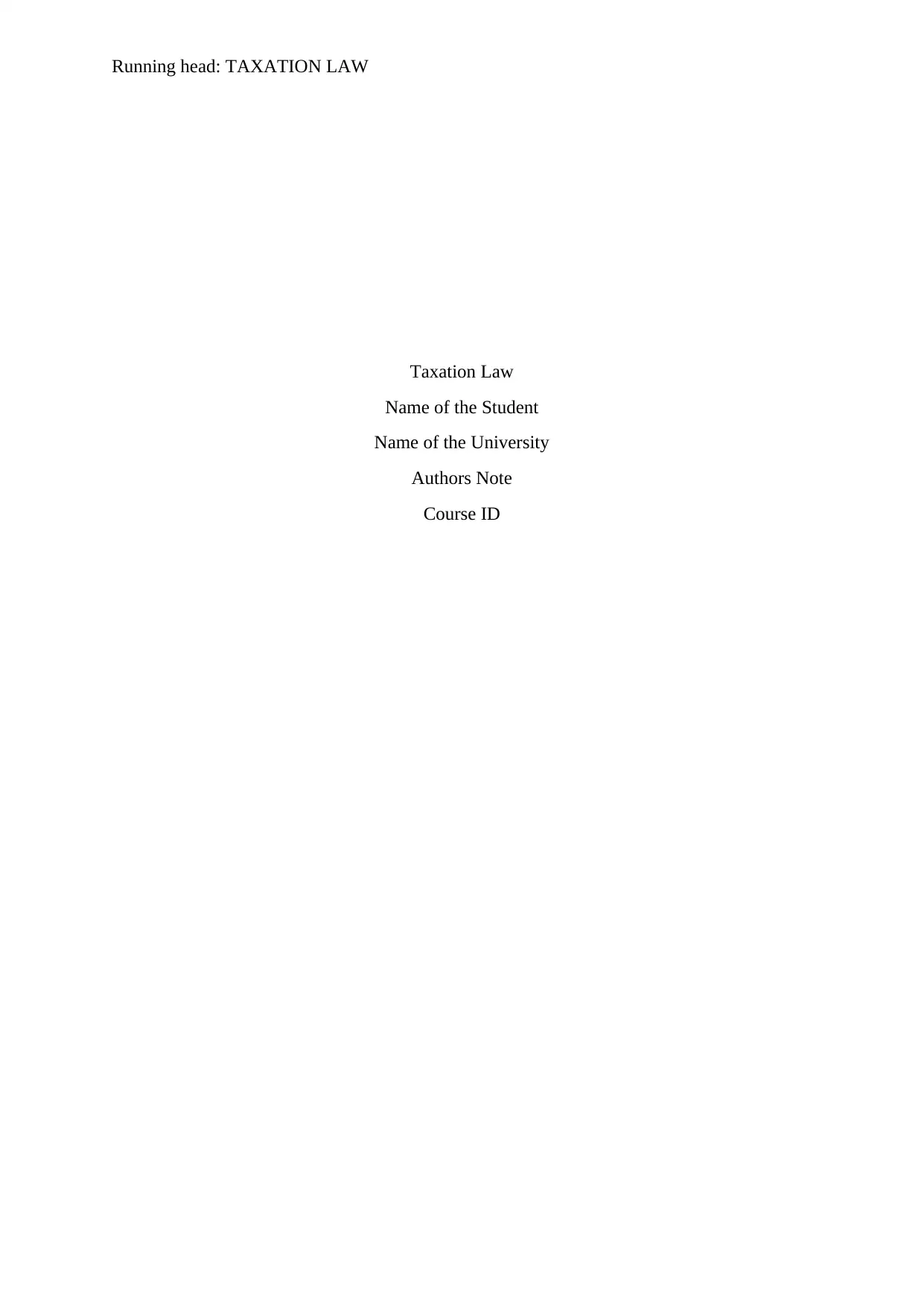
Running head: TAXATION LAW
Taxation Law
Name of the Student
Name of the University
Authors Note
Course ID
Taxation Law
Name of the Student
Name of the University
Authors Note
Course ID
Paraphrase This Document
Need a fresh take? Get an instant paraphrase of this document with our AI Paraphraser
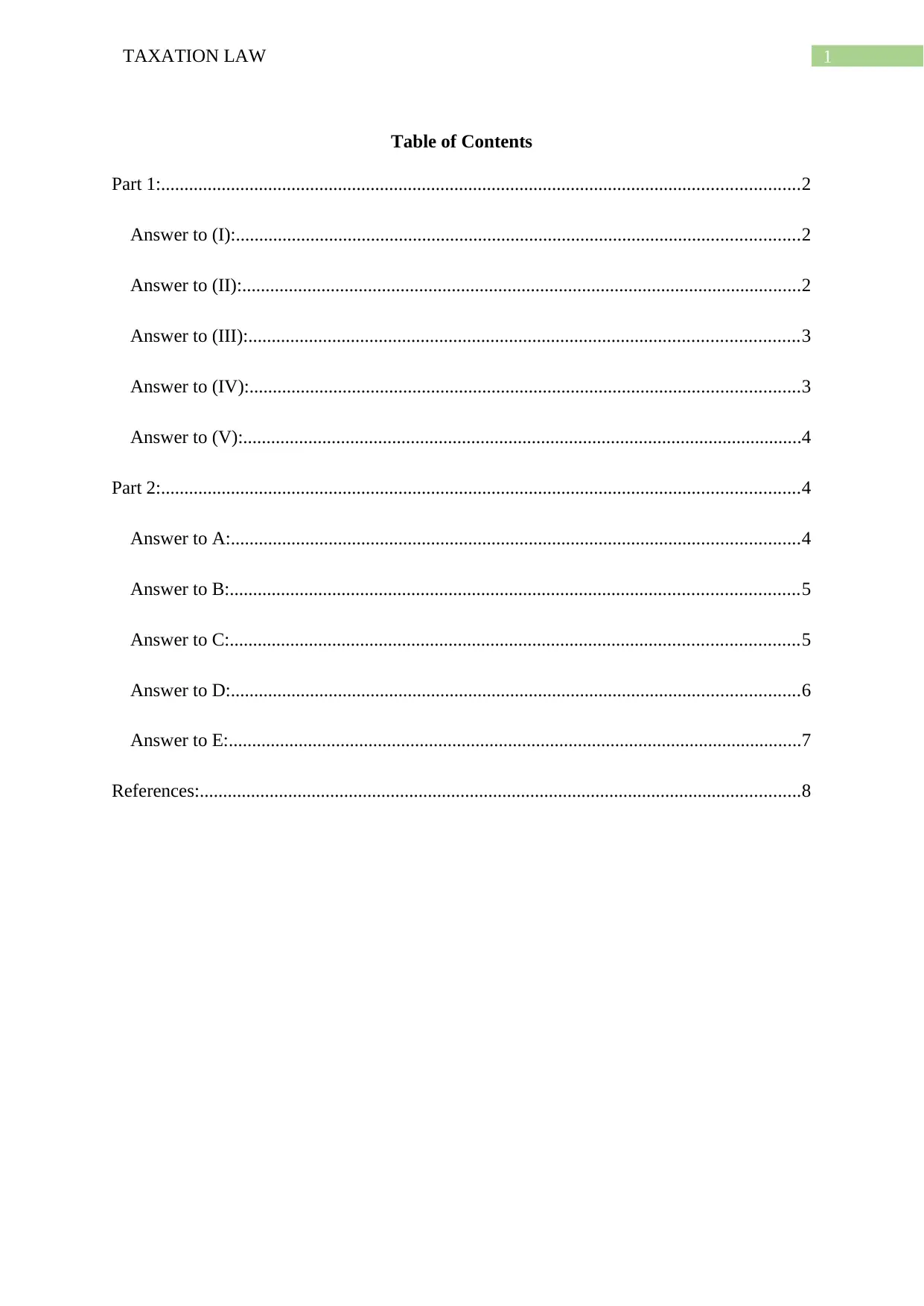
1TAXATION LAW
Table of Contents
Part 1:.........................................................................................................................................2
Answer to (I):.........................................................................................................................2
Answer to (II):........................................................................................................................2
Answer to (III):......................................................................................................................3
Answer to (IV):......................................................................................................................3
Answer to (V):........................................................................................................................4
Part 2:.........................................................................................................................................4
Answer to A:..........................................................................................................................4
Answer to B:..........................................................................................................................5
Answer to C:..........................................................................................................................5
Answer to D:..........................................................................................................................6
Answer to E:...........................................................................................................................7
References:.................................................................................................................................8
Table of Contents
Part 1:.........................................................................................................................................2
Answer to (I):.........................................................................................................................2
Answer to (II):........................................................................................................................2
Answer to (III):......................................................................................................................3
Answer to (IV):......................................................................................................................3
Answer to (V):........................................................................................................................4
Part 2:.........................................................................................................................................4
Answer to A:..........................................................................................................................4
Answer to B:..........................................................................................................................5
Answer to C:..........................................................................................................................5
Answer to D:..........................................................................................................................6
Answer to E:...........................................................................................................................7
References:.................................................................................................................................8
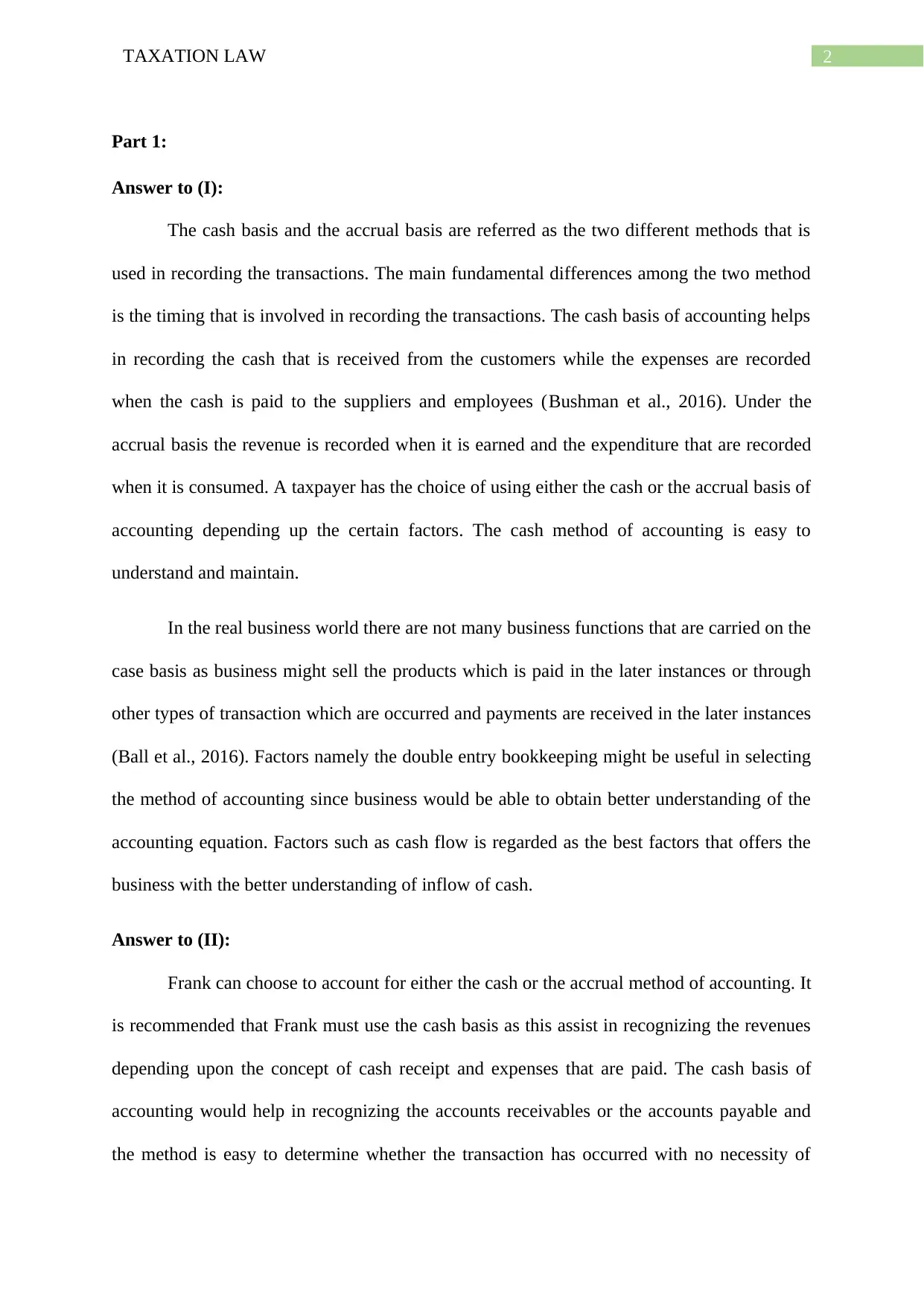
2TAXATION LAW
Part 1:
Answer to (I):
The cash basis and the accrual basis are referred as the two different methods that is
used in recording the transactions. The main fundamental differences among the two method
is the timing that is involved in recording the transactions. The cash basis of accounting helps
in recording the cash that is received from the customers while the expenses are recorded
when the cash is paid to the suppliers and employees (Bushman et al., 2016). Under the
accrual basis the revenue is recorded when it is earned and the expenditure that are recorded
when it is consumed. A taxpayer has the choice of using either the cash or the accrual basis of
accounting depending up the certain factors. The cash method of accounting is easy to
understand and maintain.
In the real business world there are not many business functions that are carried on the
case basis as business might sell the products which is paid in the later instances or through
other types of transaction which are occurred and payments are received in the later instances
(Ball et al., 2016). Factors namely the double entry bookkeeping might be useful in selecting
the method of accounting since business would be able to obtain better understanding of the
accounting equation. Factors such as cash flow is regarded as the best factors that offers the
business with the better understanding of inflow of cash.
Answer to (II):
Frank can choose to account for either the cash or the accrual method of accounting. It
is recommended that Frank must use the cash basis as this assist in recognizing the revenues
depending upon the concept of cash receipt and expenses that are paid. The cash basis of
accounting would help in recognizing the accounts receivables or the accounts payable and
the method is easy to determine whether the transaction has occurred with no necessity of
Part 1:
Answer to (I):
The cash basis and the accrual basis are referred as the two different methods that is
used in recording the transactions. The main fundamental differences among the two method
is the timing that is involved in recording the transactions. The cash basis of accounting helps
in recording the cash that is received from the customers while the expenses are recorded
when the cash is paid to the suppliers and employees (Bushman et al., 2016). Under the
accrual basis the revenue is recorded when it is earned and the expenditure that are recorded
when it is consumed. A taxpayer has the choice of using either the cash or the accrual basis of
accounting depending up the certain factors. The cash method of accounting is easy to
understand and maintain.
In the real business world there are not many business functions that are carried on the
case basis as business might sell the products which is paid in the later instances or through
other types of transaction which are occurred and payments are received in the later instances
(Ball et al., 2016). Factors namely the double entry bookkeeping might be useful in selecting
the method of accounting since business would be able to obtain better understanding of the
accounting equation. Factors such as cash flow is regarded as the best factors that offers the
business with the better understanding of inflow of cash.
Answer to (II):
Frank can choose to account for either the cash or the accrual method of accounting. It
is recommended that Frank must use the cash basis as this assist in recognizing the revenues
depending upon the concept of cash receipt and expenses that are paid. The cash basis of
accounting would help in recognizing the accounts receivables or the accounts payable and
the method is easy to determine whether the transaction has occurred with no necessity of
⊘ This is a preview!⊘
Do you want full access?
Subscribe today to unlock all pages.

Trusted by 1+ million students worldwide
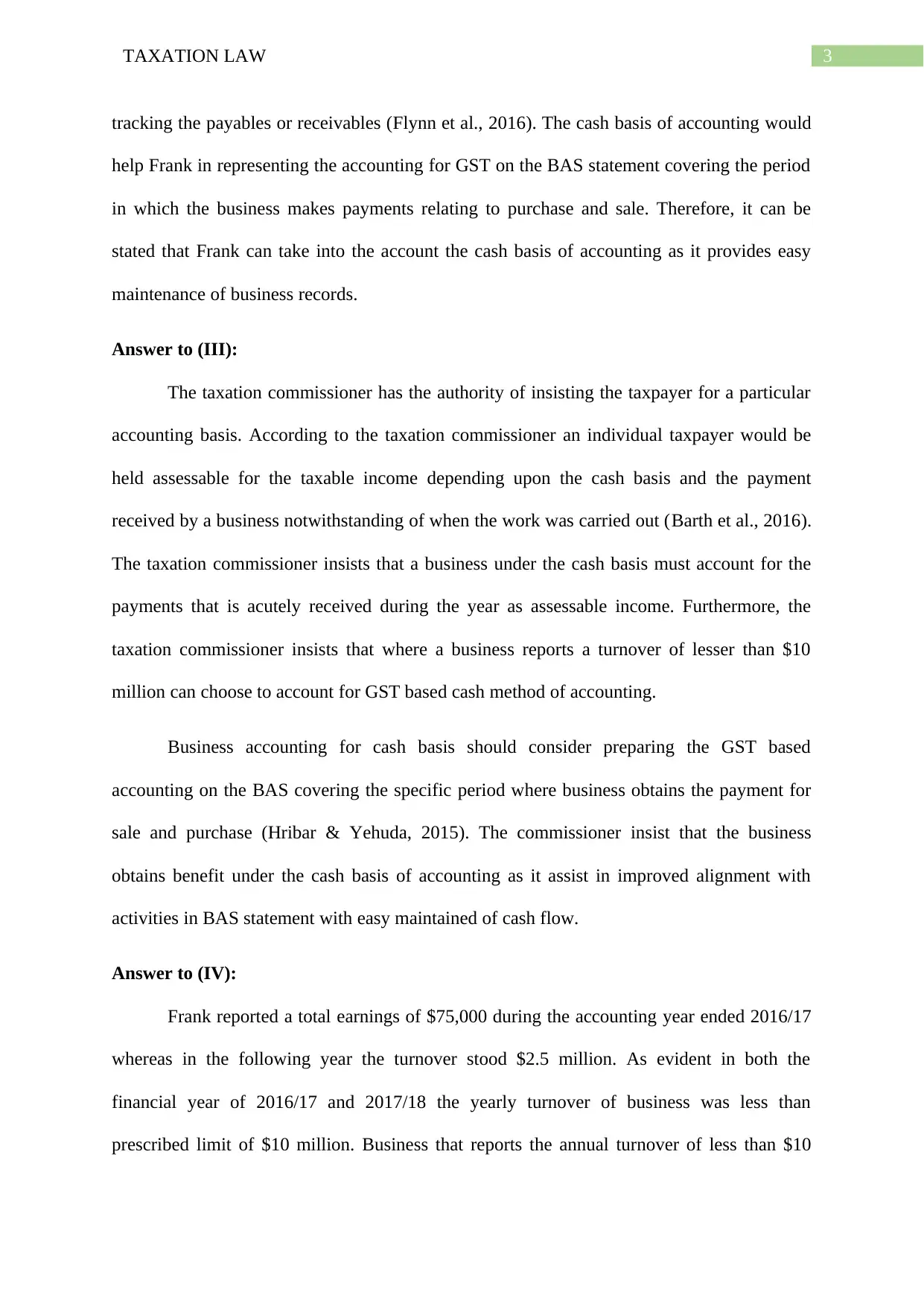
3TAXATION LAW
tracking the payables or receivables (Flynn et al., 2016). The cash basis of accounting would
help Frank in representing the accounting for GST on the BAS statement covering the period
in which the business makes payments relating to purchase and sale. Therefore, it can be
stated that Frank can take into the account the cash basis of accounting as it provides easy
maintenance of business records.
Answer to (III):
The taxation commissioner has the authority of insisting the taxpayer for a particular
accounting basis. According to the taxation commissioner an individual taxpayer would be
held assessable for the taxable income depending upon the cash basis and the payment
received by a business notwithstanding of when the work was carried out (Barth et al., 2016).
The taxation commissioner insists that a business under the cash basis must account for the
payments that is acutely received during the year as assessable income. Furthermore, the
taxation commissioner insists that where a business reports a turnover of lesser than $10
million can choose to account for GST based cash method of accounting.
Business accounting for cash basis should consider preparing the GST based
accounting on the BAS covering the specific period where business obtains the payment for
sale and purchase (Hribar & Yehuda, 2015). The commissioner insist that the business
obtains benefit under the cash basis of accounting as it assist in improved alignment with
activities in BAS statement with easy maintained of cash flow.
Answer to (IV):
Frank reported a total earnings of $75,000 during the accounting year ended 2016/17
whereas in the following year the turnover stood $2.5 million. As evident in both the
financial year of 2016/17 and 2017/18 the yearly turnover of business was less than
prescribed limit of $10 million. Business that reports the annual turnover of less than $10
tracking the payables or receivables (Flynn et al., 2016). The cash basis of accounting would
help Frank in representing the accounting for GST on the BAS statement covering the period
in which the business makes payments relating to purchase and sale. Therefore, it can be
stated that Frank can take into the account the cash basis of accounting as it provides easy
maintenance of business records.
Answer to (III):
The taxation commissioner has the authority of insisting the taxpayer for a particular
accounting basis. According to the taxation commissioner an individual taxpayer would be
held assessable for the taxable income depending upon the cash basis and the payment
received by a business notwithstanding of when the work was carried out (Barth et al., 2016).
The taxation commissioner insists that a business under the cash basis must account for the
payments that is acutely received during the year as assessable income. Furthermore, the
taxation commissioner insists that where a business reports a turnover of lesser than $10
million can choose to account for GST based cash method of accounting.
Business accounting for cash basis should consider preparing the GST based
accounting on the BAS covering the specific period where business obtains the payment for
sale and purchase (Hribar & Yehuda, 2015). The commissioner insist that the business
obtains benefit under the cash basis of accounting as it assist in improved alignment with
activities in BAS statement with easy maintained of cash flow.
Answer to (IV):
Frank reported a total earnings of $75,000 during the accounting year ended 2016/17
whereas in the following year the turnover stood $2.5 million. As evident in both the
financial year of 2016/17 and 2017/18 the yearly turnover of business was less than
prescribed limit of $10 million. Business that reports the annual turnover of less than $10
Paraphrase This Document
Need a fresh take? Get an instant paraphrase of this document with our AI Paraphraser
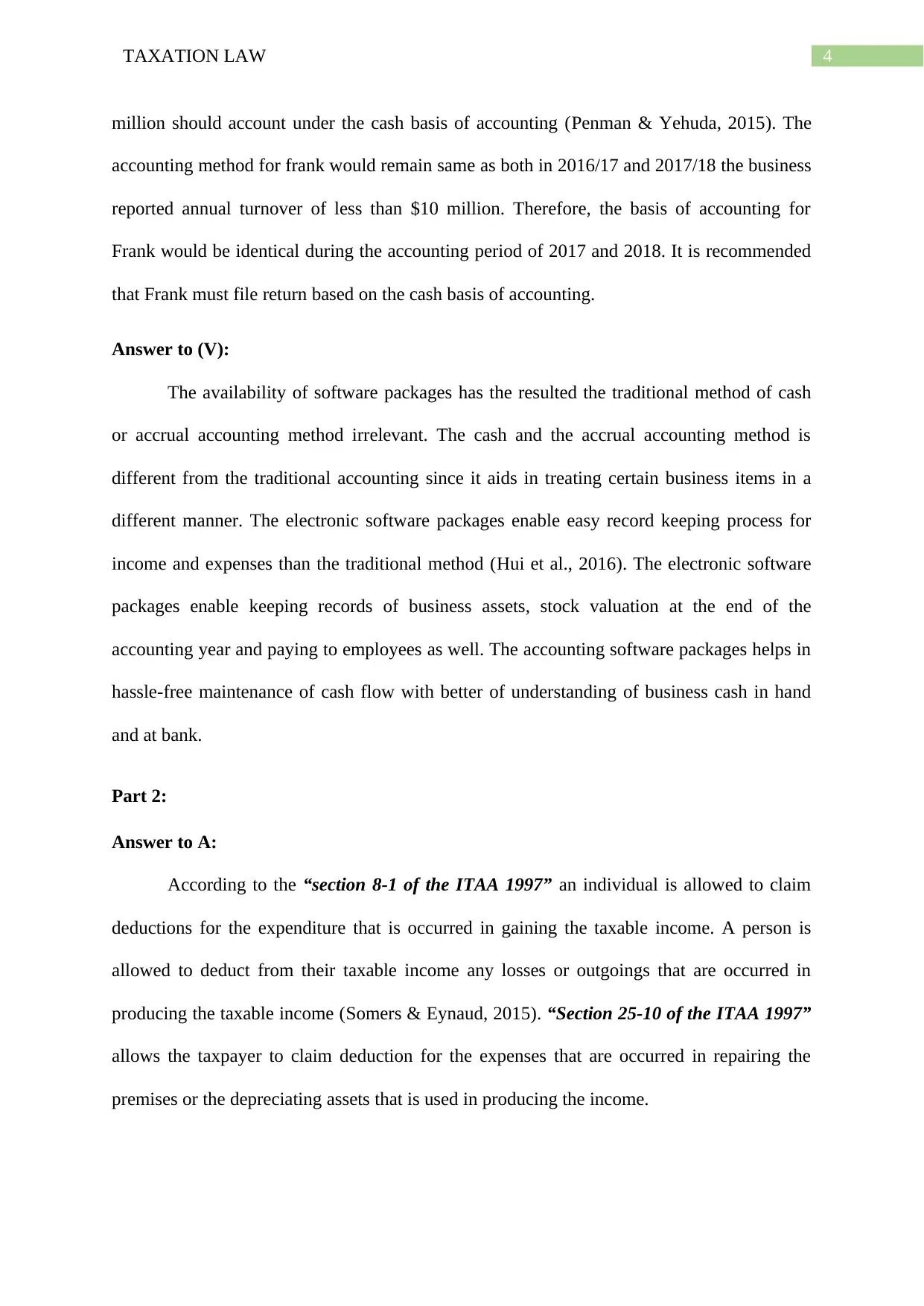
4TAXATION LAW
million should account under the cash basis of accounting (Penman & Yehuda, 2015). The
accounting method for frank would remain same as both in 2016/17 and 2017/18 the business
reported annual turnover of less than $10 million. Therefore, the basis of accounting for
Frank would be identical during the accounting period of 2017 and 2018. It is recommended
that Frank must file return based on the cash basis of accounting.
Answer to (V):
The availability of software packages has the resulted the traditional method of cash
or accrual accounting method irrelevant. The cash and the accrual accounting method is
different from the traditional accounting since it aids in treating certain business items in a
different manner. The electronic software packages enable easy record keeping process for
income and expenses than the traditional method (Hui et al., 2016). The electronic software
packages enable keeping records of business assets, stock valuation at the end of the
accounting year and paying to employees as well. The accounting software packages helps in
hassle-free maintenance of cash flow with better of understanding of business cash in hand
and at bank.
Part 2:
Answer to A:
According to the “section 8-1 of the ITAA 1997” an individual is allowed to claim
deductions for the expenditure that is occurred in gaining the taxable income. A person is
allowed to deduct from their taxable income any losses or outgoings that are occurred in
producing the taxable income (Somers & Eynaud, 2015). “Section 25-10 of the ITAA 1997”
allows the taxpayer to claim deduction for the expenses that are occurred in repairing the
premises or the depreciating assets that is used in producing the income.
million should account under the cash basis of accounting (Penman & Yehuda, 2015). The
accounting method for frank would remain same as both in 2016/17 and 2017/18 the business
reported annual turnover of less than $10 million. Therefore, the basis of accounting for
Frank would be identical during the accounting period of 2017 and 2018. It is recommended
that Frank must file return based on the cash basis of accounting.
Answer to (V):
The availability of software packages has the resulted the traditional method of cash
or accrual accounting method irrelevant. The cash and the accrual accounting method is
different from the traditional accounting since it aids in treating certain business items in a
different manner. The electronic software packages enable easy record keeping process for
income and expenses than the traditional method (Hui et al., 2016). The electronic software
packages enable keeping records of business assets, stock valuation at the end of the
accounting year and paying to employees as well. The accounting software packages helps in
hassle-free maintenance of cash flow with better of understanding of business cash in hand
and at bank.
Part 2:
Answer to A:
According to the “section 8-1 of the ITAA 1997” an individual is allowed to claim
deductions for the expenditure that is occurred in gaining the taxable income. A person is
allowed to deduct from their taxable income any losses or outgoings that are occurred in
producing the taxable income (Somers & Eynaud, 2015). “Section 25-10 of the ITAA 1997”
allows the taxpayer to claim deduction for the expenses that are occurred in repairing the
premises or the depreciating assets that is used in producing the income.
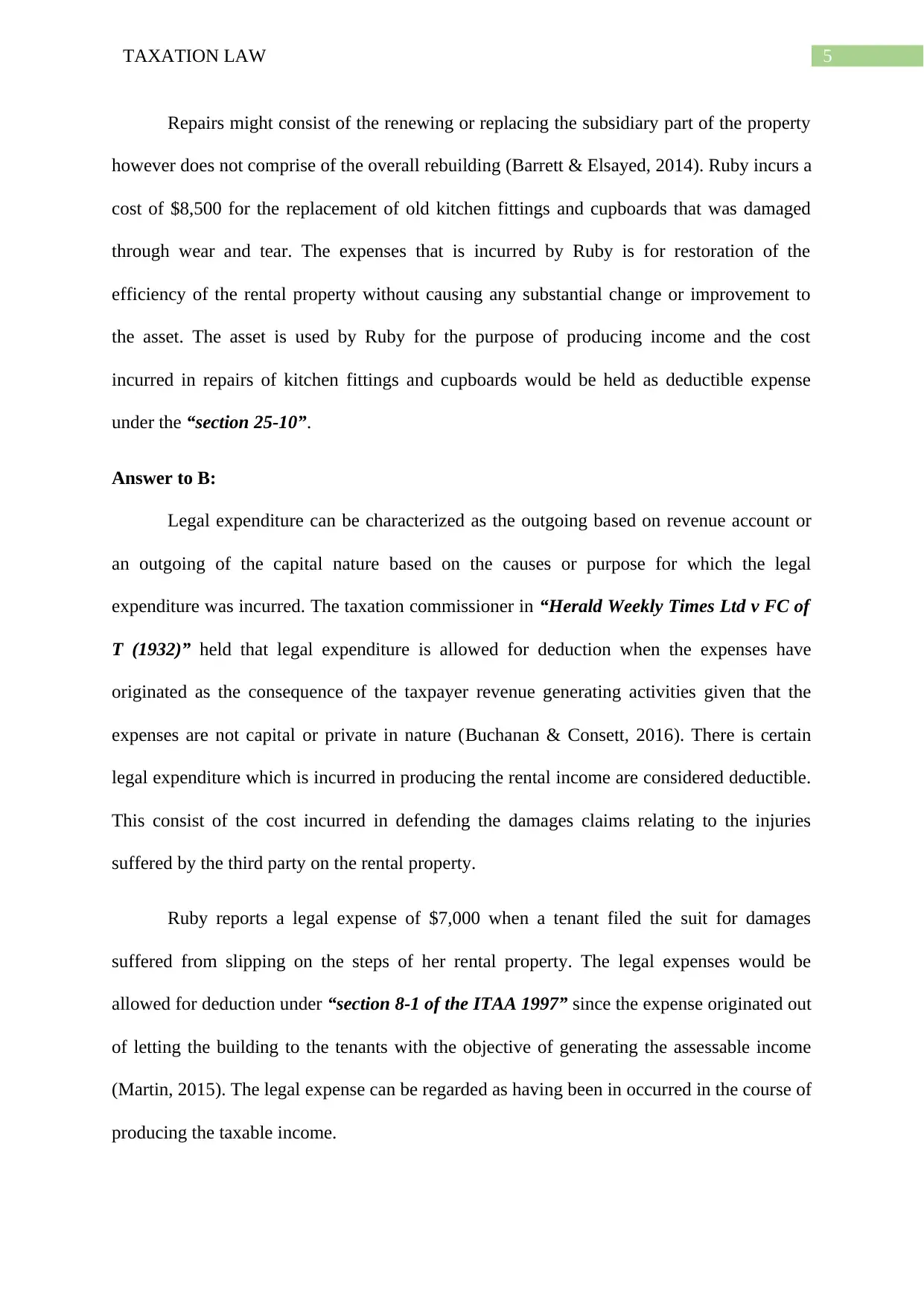
5TAXATION LAW
Repairs might consist of the renewing or replacing the subsidiary part of the property
however does not comprise of the overall rebuilding (Barrett & Elsayed, 2014). Ruby incurs a
cost of $8,500 for the replacement of old kitchen fittings and cupboards that was damaged
through wear and tear. The expenses that is incurred by Ruby is for restoration of the
efficiency of the rental property without causing any substantial change or improvement to
the asset. The asset is used by Ruby for the purpose of producing income and the cost
incurred in repairs of kitchen fittings and cupboards would be held as deductible expense
under the “section 25-10”.
Answer to B:
Legal expenditure can be characterized as the outgoing based on revenue account or
an outgoing of the capital nature based on the causes or purpose for which the legal
expenditure was incurred. The taxation commissioner in “Herald Weekly Times Ltd v FC of
T (1932)” held that legal expenditure is allowed for deduction when the expenses have
originated as the consequence of the taxpayer revenue generating activities given that the
expenses are not capital or private in nature (Buchanan & Consett, 2016). There is certain
legal expenditure which is incurred in producing the rental income are considered deductible.
This consist of the cost incurred in defending the damages claims relating to the injuries
suffered by the third party on the rental property.
Ruby reports a legal expense of $7,000 when a tenant filed the suit for damages
suffered from slipping on the steps of her rental property. The legal expenses would be
allowed for deduction under “section 8-1 of the ITAA 1997” since the expense originated out
of letting the building to the tenants with the objective of generating the assessable income
(Martin, 2015). The legal expense can be regarded as having been in occurred in the course of
producing the taxable income.
Repairs might consist of the renewing or replacing the subsidiary part of the property
however does not comprise of the overall rebuilding (Barrett & Elsayed, 2014). Ruby incurs a
cost of $8,500 for the replacement of old kitchen fittings and cupboards that was damaged
through wear and tear. The expenses that is incurred by Ruby is for restoration of the
efficiency of the rental property without causing any substantial change or improvement to
the asset. The asset is used by Ruby for the purpose of producing income and the cost
incurred in repairs of kitchen fittings and cupboards would be held as deductible expense
under the “section 25-10”.
Answer to B:
Legal expenditure can be characterized as the outgoing based on revenue account or
an outgoing of the capital nature based on the causes or purpose for which the legal
expenditure was incurred. The taxation commissioner in “Herald Weekly Times Ltd v FC of
T (1932)” held that legal expenditure is allowed for deduction when the expenses have
originated as the consequence of the taxpayer revenue generating activities given that the
expenses are not capital or private in nature (Buchanan & Consett, 2016). There is certain
legal expenditure which is incurred in producing the rental income are considered deductible.
This consist of the cost incurred in defending the damages claims relating to the injuries
suffered by the third party on the rental property.
Ruby reports a legal expense of $7,000 when a tenant filed the suit for damages
suffered from slipping on the steps of her rental property. The legal expenses would be
allowed for deduction under “section 8-1 of the ITAA 1997” since the expense originated out
of letting the building to the tenants with the objective of generating the assessable income
(Martin, 2015). The legal expense can be regarded as having been in occurred in the course of
producing the taxable income.
⊘ This is a preview!⊘
Do you want full access?
Subscribe today to unlock all pages.

Trusted by 1+ million students worldwide
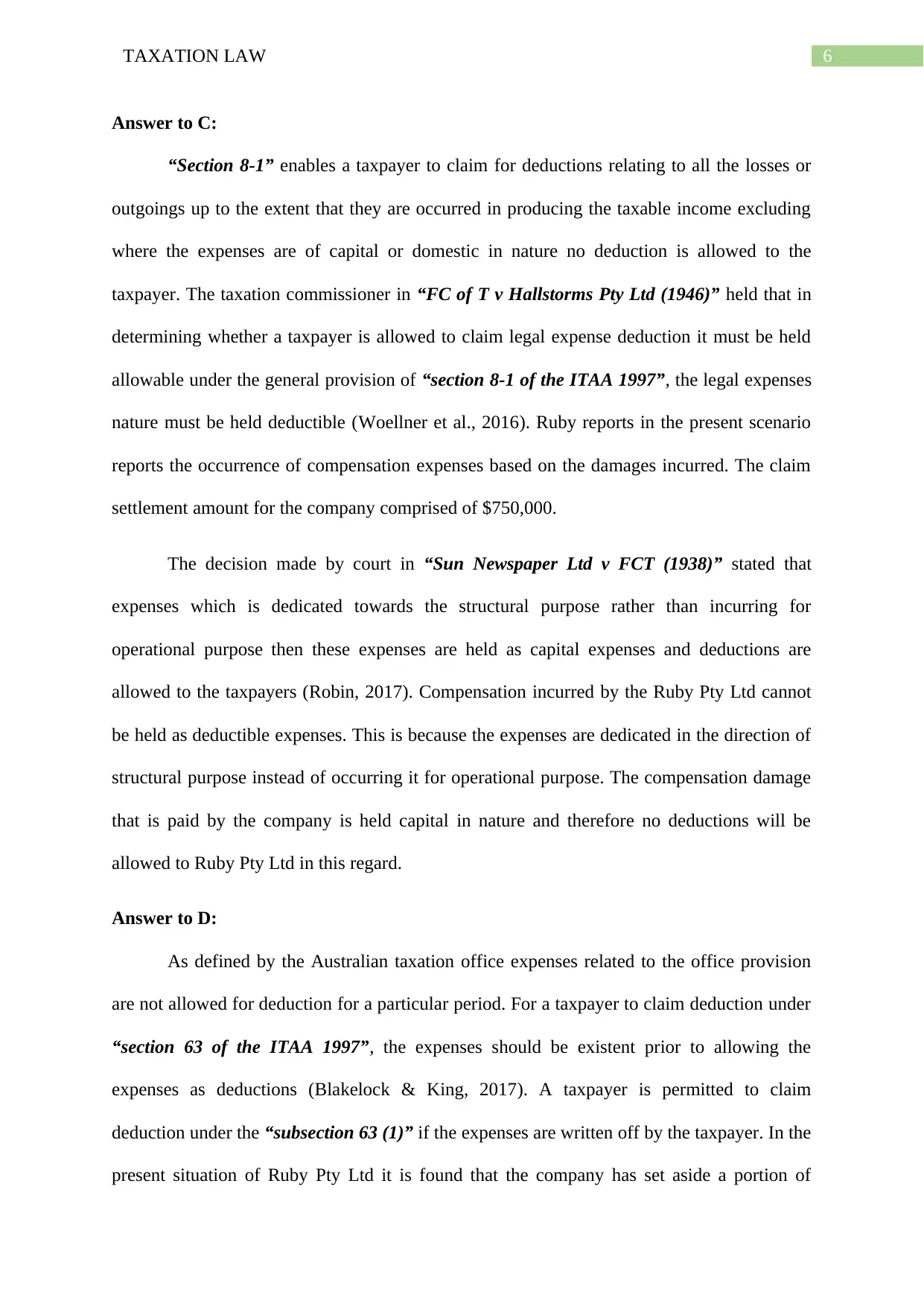
6TAXATION LAW
Answer to C:
“Section 8-1” enables a taxpayer to claim for deductions relating to all the losses or
outgoings up to the extent that they are occurred in producing the taxable income excluding
where the expenses are of capital or domestic in nature no deduction is allowed to the
taxpayer. The taxation commissioner in “FC of T v Hallstorms Pty Ltd (1946)” held that in
determining whether a taxpayer is allowed to claim legal expense deduction it must be held
allowable under the general provision of “section 8-1 of the ITAA 1997”, the legal expenses
nature must be held deductible (Woellner et al., 2016). Ruby reports in the present scenario
reports the occurrence of compensation expenses based on the damages incurred. The claim
settlement amount for the company comprised of $750,000.
The decision made by court in “Sun Newspaper Ltd v FCT (1938)” stated that
expenses which is dedicated towards the structural purpose rather than incurring for
operational purpose then these expenses are held as capital expenses and deductions are
allowed to the taxpayers (Robin, 2017). Compensation incurred by the Ruby Pty Ltd cannot
be held as deductible expenses. This is because the expenses are dedicated in the direction of
structural purpose instead of occurring it for operational purpose. The compensation damage
that is paid by the company is held capital in nature and therefore no deductions will be
allowed to Ruby Pty Ltd in this regard.
Answer to D:
As defined by the Australian taxation office expenses related to the office provision
are not allowed for deduction for a particular period. For a taxpayer to claim deduction under
“section 63 of the ITAA 1997”, the expenses should be existent prior to allowing the
expenses as deductions (Blakelock & King, 2017). A taxpayer is permitted to claim
deduction under the “subsection 63 (1)” if the expenses are written off by the taxpayer. In the
present situation of Ruby Pty Ltd it is found that the company has set aside a portion of
Answer to C:
“Section 8-1” enables a taxpayer to claim for deductions relating to all the losses or
outgoings up to the extent that they are occurred in producing the taxable income excluding
where the expenses are of capital or domestic in nature no deduction is allowed to the
taxpayer. The taxation commissioner in “FC of T v Hallstorms Pty Ltd (1946)” held that in
determining whether a taxpayer is allowed to claim legal expense deduction it must be held
allowable under the general provision of “section 8-1 of the ITAA 1997”, the legal expenses
nature must be held deductible (Woellner et al., 2016). Ruby reports in the present scenario
reports the occurrence of compensation expenses based on the damages incurred. The claim
settlement amount for the company comprised of $750,000.
The decision made by court in “Sun Newspaper Ltd v FCT (1938)” stated that
expenses which is dedicated towards the structural purpose rather than incurring for
operational purpose then these expenses are held as capital expenses and deductions are
allowed to the taxpayers (Robin, 2017). Compensation incurred by the Ruby Pty Ltd cannot
be held as deductible expenses. This is because the expenses are dedicated in the direction of
structural purpose instead of occurring it for operational purpose. The compensation damage
that is paid by the company is held capital in nature and therefore no deductions will be
allowed to Ruby Pty Ltd in this regard.
Answer to D:
As defined by the Australian taxation office expenses related to the office provision
are not allowed for deduction for a particular period. For a taxpayer to claim deduction under
“section 63 of the ITAA 1997”, the expenses should be existent prior to allowing the
expenses as deductions (Blakelock & King, 2017). A taxpayer is permitted to claim
deduction under the “subsection 63 (1)” if the expenses are written off by the taxpayer. In the
present situation of Ruby Pty Ltd it is found that the company has set aside a portion of
Paraphrase This Document
Need a fresh take? Get an instant paraphrase of this document with our AI Paraphraser
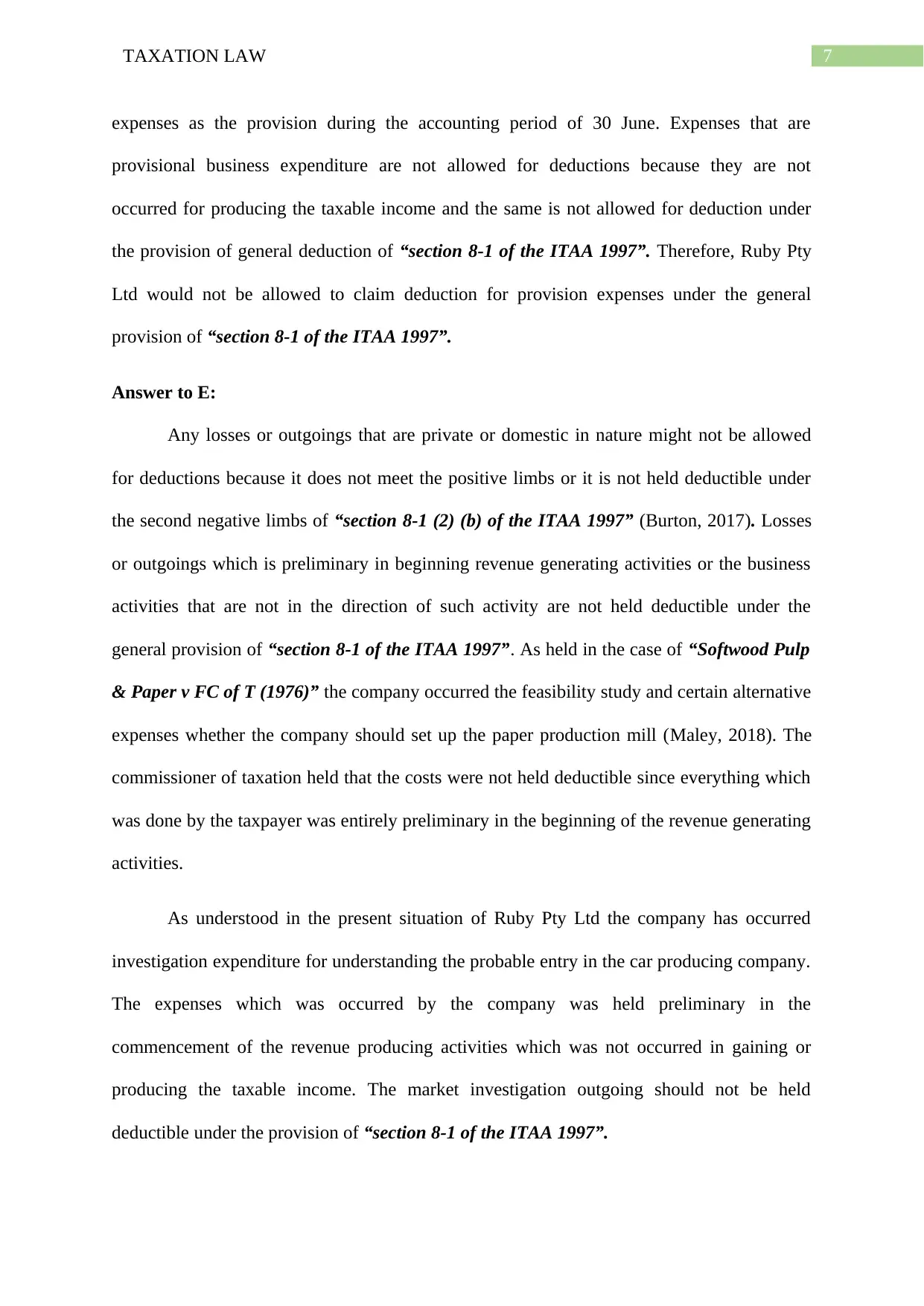
7TAXATION LAW
expenses as the provision during the accounting period of 30 June. Expenses that are
provisional business expenditure are not allowed for deductions because they are not
occurred for producing the taxable income and the same is not allowed for deduction under
the provision of general deduction of “section 8-1 of the ITAA 1997”. Therefore, Ruby Pty
Ltd would not be allowed to claim deduction for provision expenses under the general
provision of “section 8-1 of the ITAA 1997”.
Answer to E:
Any losses or outgoings that are private or domestic in nature might not be allowed
for deductions because it does not meet the positive limbs or it is not held deductible under
the second negative limbs of “section 8-1 (2) (b) of the ITAA 1997” (Burton, 2017). Losses
or outgoings which is preliminary in beginning revenue generating activities or the business
activities that are not in the direction of such activity are not held deductible under the
general provision of “section 8-1 of the ITAA 1997”. As held in the case of “Softwood Pulp
& Paper v FC of T (1976)” the company occurred the feasibility study and certain alternative
expenses whether the company should set up the paper production mill (Maley, 2018). The
commissioner of taxation held that the costs were not held deductible since everything which
was done by the taxpayer was entirely preliminary in the beginning of the revenue generating
activities.
As understood in the present situation of Ruby Pty Ltd the company has occurred
investigation expenditure for understanding the probable entry in the car producing company.
The expenses which was occurred by the company was held preliminary in the
commencement of the revenue producing activities which was not occurred in gaining or
producing the taxable income. The market investigation outgoing should not be held
deductible under the provision of “section 8-1 of the ITAA 1997”.
expenses as the provision during the accounting period of 30 June. Expenses that are
provisional business expenditure are not allowed for deductions because they are not
occurred for producing the taxable income and the same is not allowed for deduction under
the provision of general deduction of “section 8-1 of the ITAA 1997”. Therefore, Ruby Pty
Ltd would not be allowed to claim deduction for provision expenses under the general
provision of “section 8-1 of the ITAA 1997”.
Answer to E:
Any losses or outgoings that are private or domestic in nature might not be allowed
for deductions because it does not meet the positive limbs or it is not held deductible under
the second negative limbs of “section 8-1 (2) (b) of the ITAA 1997” (Burton, 2017). Losses
or outgoings which is preliminary in beginning revenue generating activities or the business
activities that are not in the direction of such activity are not held deductible under the
general provision of “section 8-1 of the ITAA 1997”. As held in the case of “Softwood Pulp
& Paper v FC of T (1976)” the company occurred the feasibility study and certain alternative
expenses whether the company should set up the paper production mill (Maley, 2018). The
commissioner of taxation held that the costs were not held deductible since everything which
was done by the taxpayer was entirely preliminary in the beginning of the revenue generating
activities.
As understood in the present situation of Ruby Pty Ltd the company has occurred
investigation expenditure for understanding the probable entry in the car producing company.
The expenses which was occurred by the company was held preliminary in the
commencement of the revenue producing activities which was not occurred in gaining or
producing the taxable income. The market investigation outgoing should not be held
deductible under the provision of “section 8-1 of the ITAA 1997”.
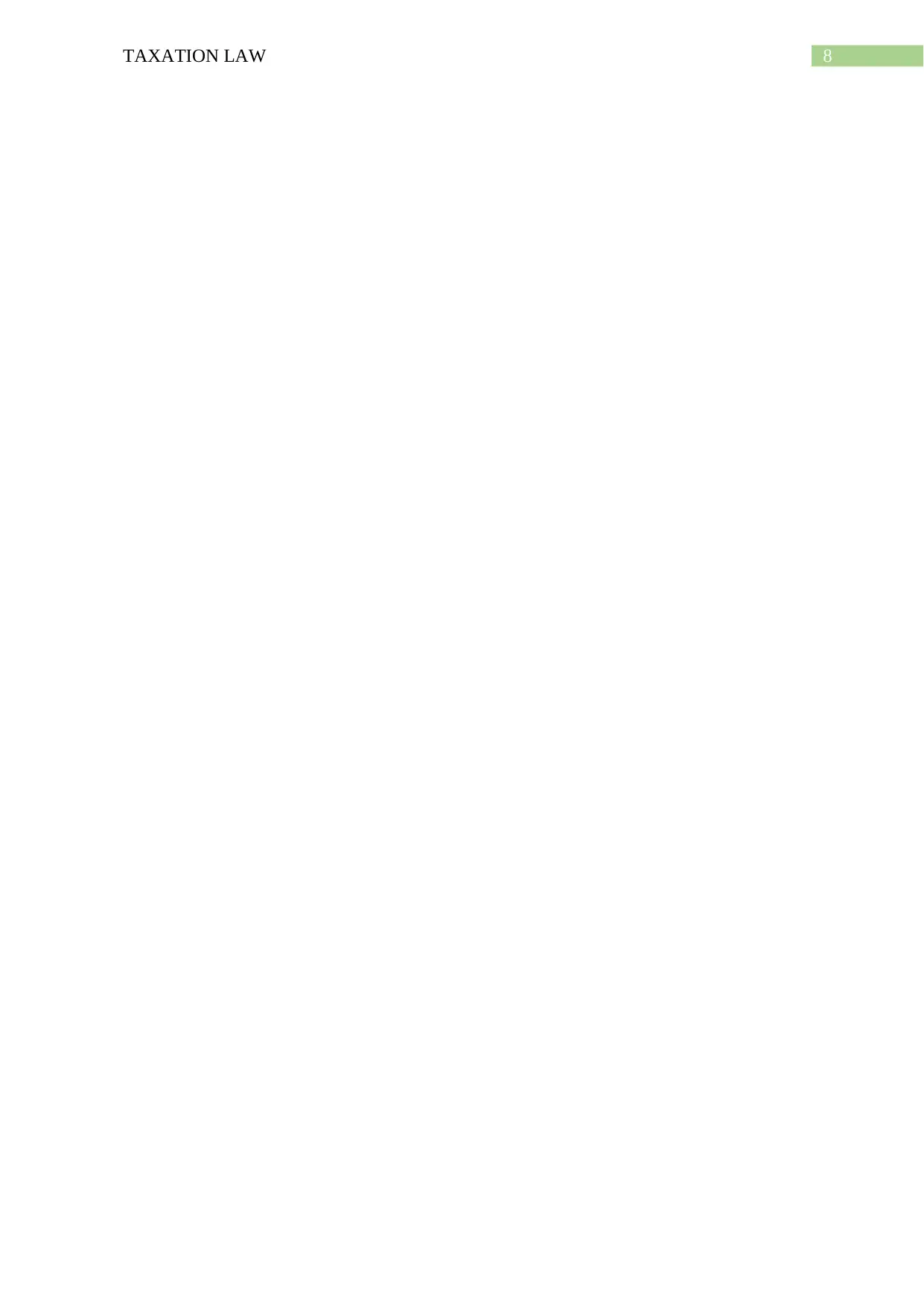
8TAXATION LAW
⊘ This is a preview!⊘
Do you want full access?
Subscribe today to unlock all pages.

Trusted by 1+ million students worldwide
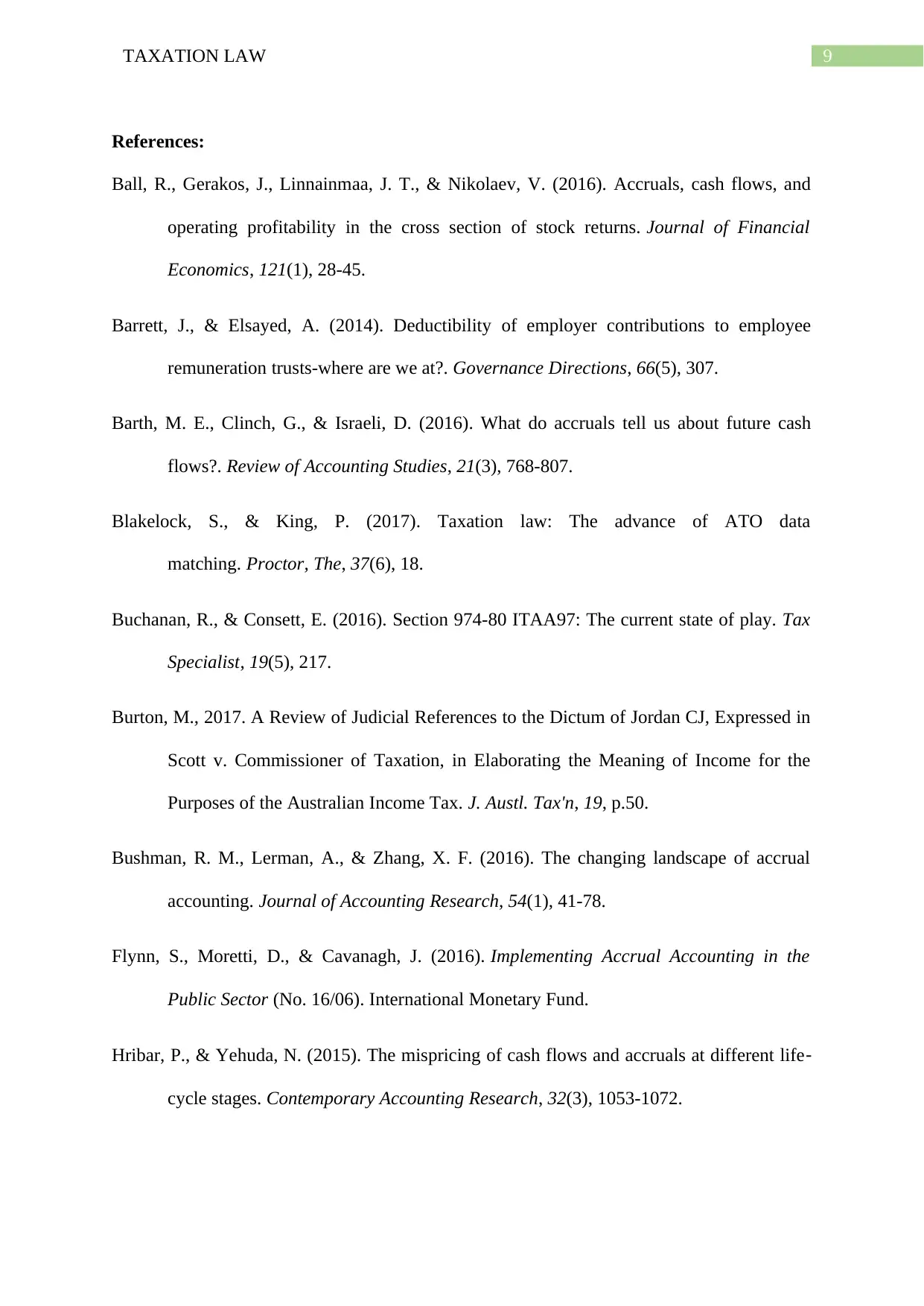
9TAXATION LAW
References:
Ball, R., Gerakos, J., Linnainmaa, J. T., & Nikolaev, V. (2016). Accruals, cash flows, and
operating profitability in the cross section of stock returns. Journal of Financial
Economics, 121(1), 28-45.
Barrett, J., & Elsayed, A. (2014). Deductibility of employer contributions to employee
remuneration trusts-where are we at?. Governance Directions, 66(5), 307.
Barth, M. E., Clinch, G., & Israeli, D. (2016). What do accruals tell us about future cash
flows?. Review of Accounting Studies, 21(3), 768-807.
Blakelock, S., & King, P. (2017). Taxation law: The advance of ATO data
matching. Proctor, The, 37(6), 18.
Buchanan, R., & Consett, E. (2016). Section 974-80 ITAA97: The current state of play. Tax
Specialist, 19(5), 217.
Burton, M., 2017. A Review of Judicial References to the Dictum of Jordan CJ, Expressed in
Scott v. Commissioner of Taxation, in Elaborating the Meaning of Income for the
Purposes of the Australian Income Tax. J. Austl. Tax'n, 19, p.50.
Bushman, R. M., Lerman, A., & Zhang, X. F. (2016). The changing landscape of accrual
accounting. Journal of Accounting Research, 54(1), 41-78.
Flynn, S., Moretti, D., & Cavanagh, J. (2016). Implementing Accrual Accounting in the
Public Sector (No. 16/06). International Monetary Fund.
Hribar, P., & Yehuda, N. (2015). The mispricing of cash flows and accruals at different life‐
cycle stages. Contemporary Accounting Research, 32(3), 1053-1072.
References:
Ball, R., Gerakos, J., Linnainmaa, J. T., & Nikolaev, V. (2016). Accruals, cash flows, and
operating profitability in the cross section of stock returns. Journal of Financial
Economics, 121(1), 28-45.
Barrett, J., & Elsayed, A. (2014). Deductibility of employer contributions to employee
remuneration trusts-where are we at?. Governance Directions, 66(5), 307.
Barth, M. E., Clinch, G., & Israeli, D. (2016). What do accruals tell us about future cash
flows?. Review of Accounting Studies, 21(3), 768-807.
Blakelock, S., & King, P. (2017). Taxation law: The advance of ATO data
matching. Proctor, The, 37(6), 18.
Buchanan, R., & Consett, E. (2016). Section 974-80 ITAA97: The current state of play. Tax
Specialist, 19(5), 217.
Burton, M., 2017. A Review of Judicial References to the Dictum of Jordan CJ, Expressed in
Scott v. Commissioner of Taxation, in Elaborating the Meaning of Income for the
Purposes of the Australian Income Tax. J. Austl. Tax'n, 19, p.50.
Bushman, R. M., Lerman, A., & Zhang, X. F. (2016). The changing landscape of accrual
accounting. Journal of Accounting Research, 54(1), 41-78.
Flynn, S., Moretti, D., & Cavanagh, J. (2016). Implementing Accrual Accounting in the
Public Sector (No. 16/06). International Monetary Fund.
Hribar, P., & Yehuda, N. (2015). The mispricing of cash flows and accruals at different life‐
cycle stages. Contemporary Accounting Research, 32(3), 1053-1072.
Paraphrase This Document
Need a fresh take? Get an instant paraphrase of this document with our AI Paraphraser
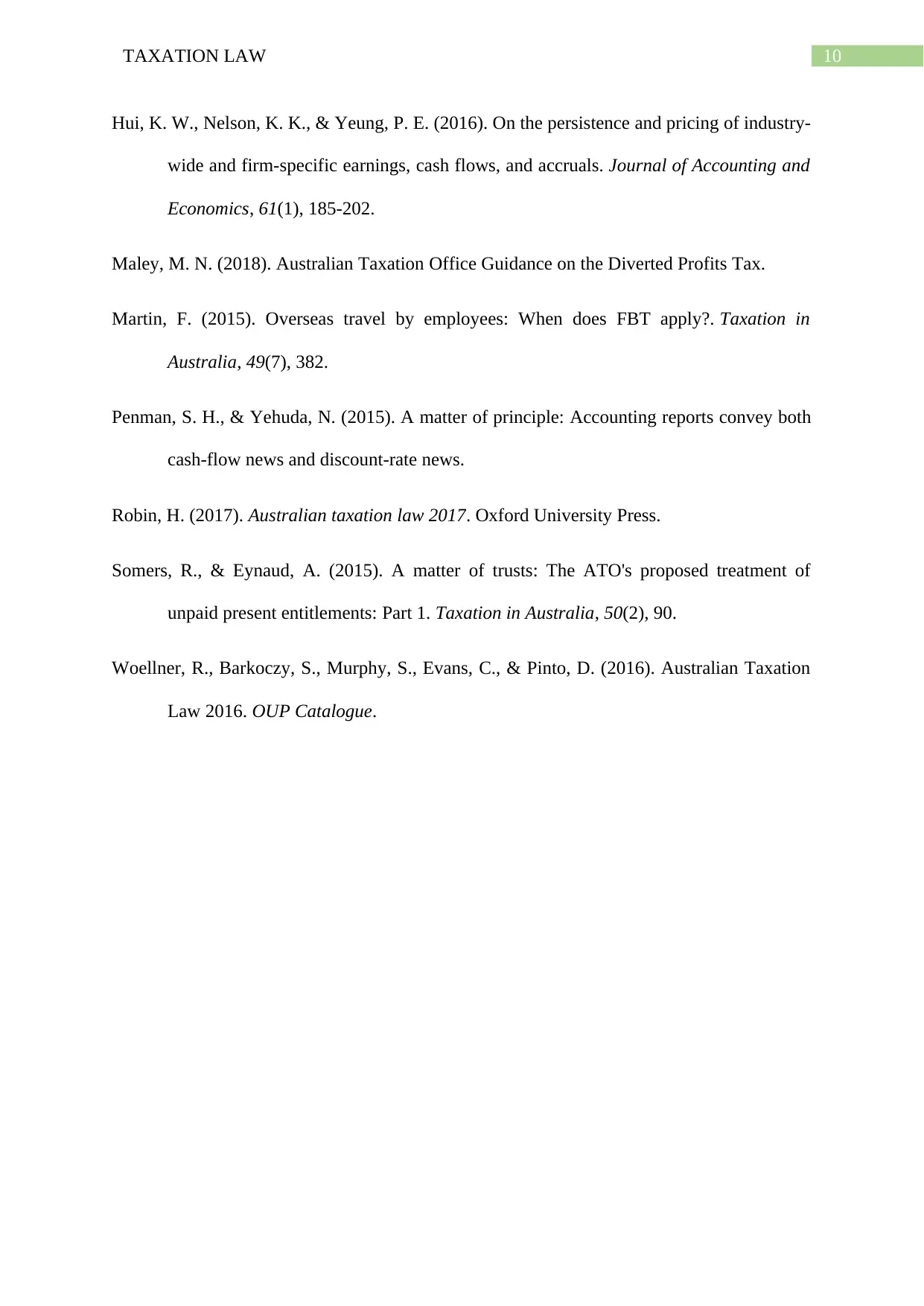
10TAXATION LAW
Hui, K. W., Nelson, K. K., & Yeung, P. E. (2016). On the persistence and pricing of industry-
wide and firm-specific earnings, cash flows, and accruals. Journal of Accounting and
Economics, 61(1), 185-202.
Maley, M. N. (2018). Australian Taxation Office Guidance on the Diverted Profits Tax.
Martin, F. (2015). Overseas travel by employees: When does FBT apply?. Taxation in
Australia, 49(7), 382.
Penman, S. H., & Yehuda, N. (2015). A matter of principle: Accounting reports convey both
cash-flow news and discount-rate news.
Robin, H. (2017). Australian taxation law 2017. Oxford University Press.
Somers, R., & Eynaud, A. (2015). A matter of trusts: The ATO's proposed treatment of
unpaid present entitlements: Part 1. Taxation in Australia, 50(2), 90.
Woellner, R., Barkoczy, S., Murphy, S., Evans, C., & Pinto, D. (2016). Australian Taxation
Law 2016. OUP Catalogue.
Hui, K. W., Nelson, K. K., & Yeung, P. E. (2016). On the persistence and pricing of industry-
wide and firm-specific earnings, cash flows, and accruals. Journal of Accounting and
Economics, 61(1), 185-202.
Maley, M. N. (2018). Australian Taxation Office Guidance on the Diverted Profits Tax.
Martin, F. (2015). Overseas travel by employees: When does FBT apply?. Taxation in
Australia, 49(7), 382.
Penman, S. H., & Yehuda, N. (2015). A matter of principle: Accounting reports convey both
cash-flow news and discount-rate news.
Robin, H. (2017). Australian taxation law 2017. Oxford University Press.
Somers, R., & Eynaud, A. (2015). A matter of trusts: The ATO's proposed treatment of
unpaid present entitlements: Part 1. Taxation in Australia, 50(2), 90.
Woellner, R., Barkoczy, S., Murphy, S., Evans, C., & Pinto, D. (2016). Australian Taxation
Law 2016. OUP Catalogue.
1 out of 11
Related Documents
Your All-in-One AI-Powered Toolkit for Academic Success.
+13062052269
info@desklib.com
Available 24*7 on WhatsApp / Email
![[object Object]](/_next/static/media/star-bottom.7253800d.svg)
Unlock your academic potential
Copyright © 2020–2025 A2Z Services. All Rights Reserved. Developed and managed by ZUCOL.



